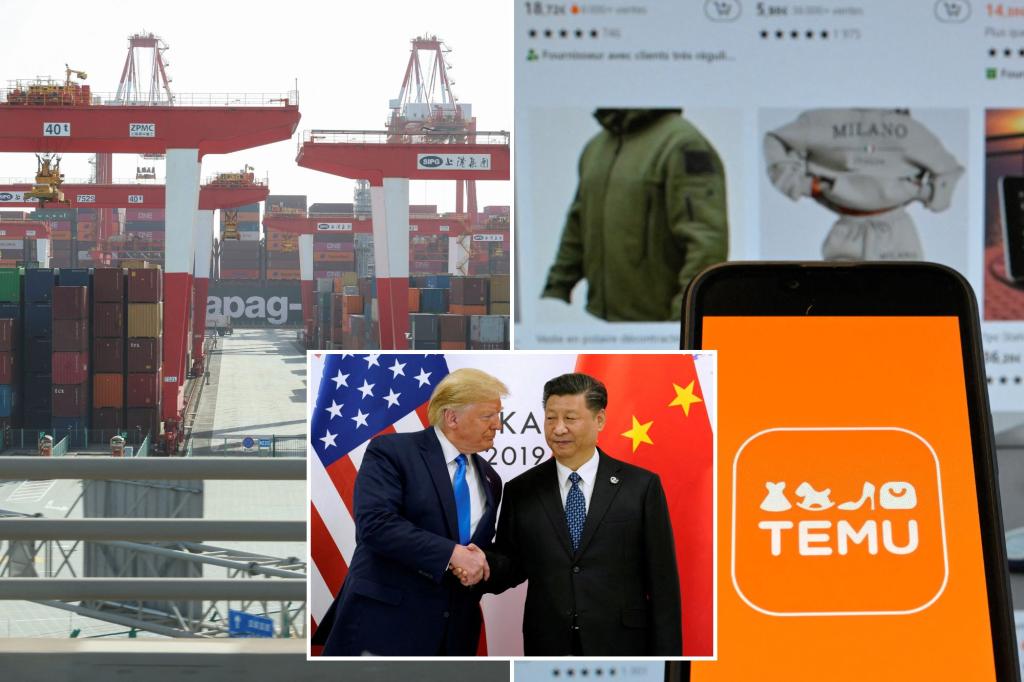
Just a few days after President Trump’s administration officially canceled the duty-free access for inexpensive Chinese imports to the United States, officials decided to suspend the implementation of this order. This change came in response to a significant backlog at New York’s John F. Kennedy International Airport, where over a million packages were waiting to be processed.
The rushed and unclear nature of the policy shift created operational challenges that made it impractical to execute immediately. As a result, government officials are now frantically trying to enforce the order without disrupting the highly efficient U.S. import system.
Trump’s executive action specifically targeted a little-known trade provision known as “de minimis.”
This rule allows merchandise valued at less than $800 to enter the U.S. without duties and with minimal inspections.
In recent years, the volume of shipments utilizing this tax-free route has surged, resulting in approximately 1.4 billion packages arriving in the U.S. last year, primarily fueled by the rise of online shopping.
Currently, over 90% of incoming packages enter the U.S. under the de minimis exemption, with about 60% coming from China, chiefly from direct-to-consumer online brands like Temu and Shein.
Trump had previously campaigned on the promise to hold China accountable for its role in the synthetic opioid epidemic that has taken more than 450,000 American lives over the past decade.
According to U.S. anti-narcotics officials, Chinese chemical manufacturers are the primary suppliers of raw materials used by Mexican cartels to produce the lethal drug.
A Reuters investigation uncovered how traffickers exploit the de minimis rule to route these chemicals through the U.S.
China has consistently denied any wrongdoing.
By issuing an executive order on February 1, Trump announced a new 10% tariff on all Chinese imports and revoked the de minimis exemption specifically for low-value goods from China.
The administration allowed only three days for the new policy to be enacted. By February 7, the section of Trump’s order impacting de minimis shipments was put on pause due to inadequate preparation time for those tasked with its enforcement.
The congestion at entry points, including JFK Airport, highlighted the operational challenges involved.
Experts in logistics indicated that it would have been impossible for major shipping carriers, e-commerce platforms, the U.S. Postal Service, and Customs and Border Protection (CBP) to swiftly modify their operations within such a tight timeframe, particularly with millions of de minimis packages already being shipped from China.
“You can’t just snap your fingers and expect everything to change instantly,” stated John Leonard, a former senior official at CBP who retired in 2024.
He noted that implementing such significant changes typically takes months and requires collaboration between CBP and the private sector.
The de minimis rule, originating in 1938, has garnered criticism from lawmakers on both sides of the aisle. Some have labeled it a loophole that enables an influx of inexpensive Chinese products that adversely impact American industries while providing a means for smuggling contraband, including illegal drugs and their precursor chemicals.
A series by Reuters last year explored the supply chain for fentanyl precursors and demonstrated how traffickers exploit the vast quantities of de minimis packages to smuggle chemicals into the U.S.
Despite a growing consensus on the need to reduce imports through the de minimis rule, experts warn that any adjustments to the policy must be carefully considered and implemented with a timeline that allows shipping companies and CBP adequate time to adapt.
The requirement for duties on the millions of low-value packages from China could also hinder a shipping system designed for rapid parcel movement, which struggles to handle large volumes of goods for extended periods.
American consumers have grown accustomed to swift delivery for affordable products from China.
U.S. Representative Rosa DeLauro (D-Conn.) advocates for the complete elimination of de minimis exemptions for all countries, not solely those from China.
However, she criticized Trump’s abrupt directive for catching the shipping industry off guard, emphasizing that typically, the government would seek input from impacted parties and allow for a thoughtful preparation period.
“Some infrastructure needs to be in place first,” DeLauro stated. “You can’t declare sweeping changes and fail to plan how to implement them effectively.”
She also critiqued Trump’s order for its narrow geographic focus, suggesting that companies producing goods in China could simply relocate operations to countries like Vietnam and Thailand to evade the de minimis restrictions.
The Commerce Department has now been tasked with figuring out a viable way to implement Trump’s policy.
A particular hurdle lies with the government-run United States Postal Service (USPS).
Although USPS handled only about 5% of last year’s de minimis shipments, equating to around 75 million packages, experts believe it poses a significant challenge to any efforts aimed at revoking tariff exemptions on low-value shipments.
USPS’s operational history is based on mail delivery rather than processing and collecting duties on incoming packages containing clothing, accessories, and electronics from overseas.
In contrast, express carriers like FedEx, UPS, and DHL have dedicated customs brokerage divisions, managing the entire logistics process, from drop-off to delivery.
USPS, however, relies on international postal services that send items into a limited number of international mail facilities at major airports. Often, these packages arrive with scant information about their contents, making duty processing challenging.
“USPS has no mechanism in place to collect or remit duties to the government,” remarked Cindy Allen, CEO of Trade Force Multiplier and a former CBP agent.
Following Trump’s directive, USPS briefly halted the acceptance of incoming packages from China and Hong Kong on February 4 while determining how to manage duty collection.
Approximately 12 hours later, however, they reversed that decision.
In an official statement, USPS said it is collaborating with CBP to establish an effective duty collection process concerning the new Chinese tariffs to minimize disruption in package delivery.
To begin the duty processing for millions of incoming parcels, USPS may need to collaborate with customs brokers, experts suggested.
Another possibility would be to exempt USPS from the new tariffs; however, this could lead to an influx of low-value items into the international mail sector, where CBP has struggled to adequately screen packages for fentanyl and other illicit substances.
USPS did not respond to inquiries for comments.
Meanwhile, the U.S. Postal Inspection Service, the agency’s enforcement division, stated last year that it works diligently with Customs and other partners to combat the flow of illegal drugs via mail.
On the other hand, DHL, UPS, and FedEx affirmed their compliance with relevant regulations and their capacity to adapt to the required changes. CBP has yet to respond to inquiries regarding the situation.
Moreover, experts opine that CBP will require additional personnel to scrutinize incoming shipments effectively.
It remains uncertain where such additional staffing will be sourced, especially since the Trump administration aims to downsize the federal workforce.
An official from the Trump administration mentioned that the effort to reinstate the ban on de minimis would occur “in short order,” according to Reuters.
Whenever this occurs, a challenging implementation process may ensue, according to Lars-Erik Hjelm, an attorney specializing in international trade law and a former customs employee.
The complex global shipping routes, often involving multiple transit points before reaching the U.S., will complicate the ability to identify the true origin of goods.
“No matter what happens, it’s going to be a chaotic process,” he warned.









